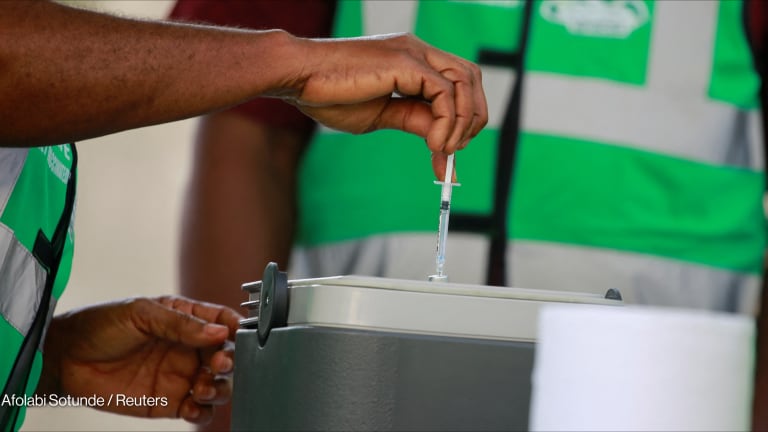
In early 2021, as the second COVID-19 wave was starting in several African countries and vaccines were scarce across the continent, African governments had the possibility of procuring COVID-19 vaccines through the African Vaccine Acquisition Trust, or AVAT, rather than wait for doses donated through COVAX to arrive.
Some countries, including Ethiopia, Kenya, and Nigeria, decided to go ahead and started procuring through AVAT, based on the notion that these investments were good value for money or that they would provide the best impact in proportion to the resources required.
But with already tight health budgets — sub-Saharan African countries spent an average of under $80 per capita on health in 2019, a tiny amount compared with high-income countries where this figure is around $6,300 — governments knew that any money spent on vaccines would be money unavailable for other essential health services.
Recent research finds that they were right. However, if these countries had procured bigger volumes, and if AVAT had managed to secure and deliver more doses and country vaccination programs had achieved initial vaccination targets in 2021, many more lives could have been saved.
In Kenya, for example, fully vaccinating 30% of the adult population and prioritizing those over the age of 50 could have reduced infections by 10% and deaths by 54%. Kenya only reached this coverage in April 2022. In Nigeria, where only about 11% of people are fully vaccinated, vaccinating just a quarter of the population, also prioritizing those over 50 years old, could have averted up to 430,000 “disability-adjusted life years” — a measure that captures years of life lost to premature death adjusted by time spent with disability or disease.
The must-read weekly newsletter for exclusive global health news and insider insights.
The benefits of an early, targeted vaccination in Africa would have extended beyond saving lives. With fewer infections to contend with, health systems could have also saved money spent on care and treatment.
Ethiopia and Nigeria, for example, could have saved as much as $200 million and $90 million respectively over five years if sufficient viral vector vaccines had been deployed in 2021. This does not mean that buying enough COVID-19 vaccines would have been cheap for African countries.
In Nigeria, for instance, the government would have had to invest between $440 million and $480 million in the first 12 months of the vaccination program for viral vector vaccines and over $1 billion for messenger RNA vaccines. Financing from the World Bank, in the form of loans or grants, was available, but it often was too little or too late. In Kenya and Nigeria, loans for $130 million and $400 million were approved in late June and September 2021 respectively, while in Ethiopia, a $207 million grant was approved in late March 2021.
Of course, securing sufficient COVID-19 vaccines alone would not have been enough to save lives and money in African countries. Policymakers had to choose the right vaccine at the right price, administer it to the right population, and do it quickly to maximize the value for money or the relationship between benefits and costs associated with COVID-19 vaccinations.
The research released by KEMRI-Wellcome Trust, the University of Nigeria, the Ethiopian Public Health Institute, the London School of Hygiene & Tropical Medicine, the University of Warwick, the Africa Centres for Disease Control and Prevention, and the Center for Global Development indicates that viral vector vaccines — such as those from AstraZeneca and Johnson & Johnson — provided better value for money than any other COVID-19 vaccines, mainly because their efficacy was high and prices low.
Paying an additional premium for mRNA vaccines was generally not worthwhile. In Ethiopia and Nigeria, for example, vaccines would not have been cost-effective, when paid with domestic resources, if the vaccine price exceeded around $10 and $6 a dose, respectively.
Many countries quickly opened up their eligibility to all adults, but targeting people at severe risk of disease rather than the whole population would also have maximized the vaccines’ benefit given that prior exposure to COVID-19 already conferred some protection to a high number of people.
The research also brings into question what level of coverage is good value for money using domestic resources in contexts where the population share of the vulnerable, such as the old, is low, and there is high levels of natural immunity due to previous infection. Many countries followed the World Health Organization and set a 70% coverage target.
In Kenya, however, expanding coverage to 50% of the population was not found to be value for money compared to the 30% coverage scenario that prioritizes those over 50 years old that are most vulnerable to severe disease and death. Finally, rapid vaccination would have been a more cost-effective strategy compared with slower rollouts. In Kenya, for example, the relationship between costs and benefits improves by nearly 20% with a fast rollout.
As African leaders and donors draw lessons from their response to the pandemic and face a future with waning immunity and potential surges caused by new variants, it is critical that they act early to vaccinate those most at risk, as quickly as possible, with an efficacious vaccine negotiated at low prices.
This approach will require strengthening mechanisms for pooled procurement and price negotiations and the recognition that pragmatic approaches targeting the vulnerable are not just more realistic than attempting to vaccinate entire populations — they are better value for money.







